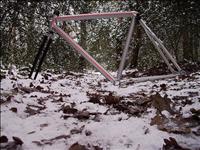|
|
| Model: | CL1 |
| Brand: | Vitus |
| Category: | Mountain Bike |
| Years: | N/A |
| Country: | France |
| Production: | Unknown |
| Sold As: | Unknown |
| Material: | - - - - |
| Construction: | Bonded |
| Drivetrain: | - - - - |
| Wheel Size: | 26" |
| Added By: | Elev12K on 12/30/10 |
| Updated By: | Elev12K on 12/30/10 |
Frame Example Photos
This Frame Model has 1 Frame Example with additional photos. Choose from the options below to view them.
 View First Photo from each Example
 View All Frame Example Photos
|
|
| Model General Information |
| Bonded aluminium mountain frame. Glued and bolted construction. For more rigidity the lugs have longer overlap than with road frames. No featherweight.
- Anodized tubing, polished lugs - Unique slotless seatpost fixation through two cilindric bits moving toward eachother and clamping the post (a system also seen on some ahead stems). - U-brake or cantis? You choose. The studs can be moved from seatstays (canti setup) to chainstays (for U-brake). - Brake and gear cables run slotted under the top or downtube. Under the downtube hidden by a cover. - Squarish top- and downtube
The original fork for the CL1 frame is an aluminium example using the same bonded and bolted construction. Not the Tange Switchblades aftermarket fork like shown with this frame example. |
 |
| Primary Example: | Vitus CL1 |
| Years: | N/A | Sold As: | Unknown |
| Bottom Bracket: | | Brake Mounting: | Cantilever studs |
| Lug Style: | | Brake Guides: | |
| Fork Style: | | Seat Stays: | |
| Fork Crown Style: | | Main Tubing: | |
| Rear Dropouts: | | Color(s): | |
|
